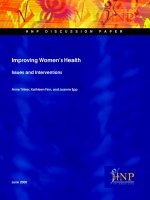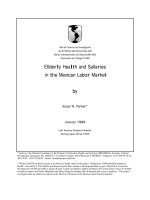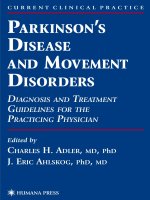Davis’s Comprehensive Laboratory and Diagnostic Test Handbook—with Nursing Implications potx
Bạn đang xem bản rút gọn của tài liệu. Xem và tải ngay bản đầy đủ của tài liệu tại đây (16.61 MB, 1,205 trang )
Davis’s Comprehensive
Laboratory and Diagnostic
Test Handbook—with Nursing
Implications
00schnell-FM 4/5/03 7:24 PM Page i
Copyright © 2003 F.A. Davis Company
00schnell-FM 4/5/03 7:24 PM Page ii
Copyright © 2003 F.A. Davis Company
This page intentionally left blank
Davis’s Comprehensive
Laboratory and
Diagnostic Test
Handbook—with
Nursing Implications
Zoanne Burgess Schnell, PhD, RN
Anne M. Van Leeuwen, MA, BS, MT(ASCP)
Todd R. Kranpitz, MS, BS, NMT, ARRT
F. A. DAVIS COMPANY • PHILADELPHIA
00schnell-FM 4/5/03 7:24 PM Page iii
Copyright © 2003 F.A. Davis Company
F. A. Davis Company
1915 Arch Street
Philadelphia, PA 19103
www.fadavis.com
Copyright © 2003 by F. A. Davis Company
All rights reserved. This book is protected by copyright. No part of it may be reproduced,
stored in a retrieval system, or transmitted in any form or by any means, electronic, mechanical,
photocopying, recording, or otherwise, without written permission from the publisher.
Printed in Canada
Last digit indicates print number: 10 9 8 7 6 5 4 3 2 1
Acquisitions Editor: Lisa B. Deitch
Developmental Editor: Gett Services
Production Editor: Lisa J. Collins
Cover Designer: Louis J. Forgione
As new scientific information becomes available through basic and clinical research,
recommended treatments and drug therapies undergo changes. The authors and publisher have
done everything possible to make this book accurate, up to date, and in accord with accepted
standards at the time of publication. The authors, editors, and publisher are not responsible for
errors or omissions or for consequences from application of the book, and make no warranty,
expressed or implied, in regard to the contents of the book. Any practice described in this
book should be applied by the reader in accordance with professional standards of care used in
regard to the unique circumstances that may apply in each situation. The reader is advised
always to check product information (package inserts) for changes and new information
regarding dose and contraindications before administering any drug. Caution is especially
urged when using new or infrequently ordered drugs.
ISBN 0-8036-1042-4
Authorization to photocopy items for internal or personal use, or the internal or personal
use of specific clients, is granted by F. A. Davis Company for users registered with the
Copyright Clearance Center (CCC) Transactional Reporting Service, provided that the fee
of $.10 per copy is paid directly to CCC, 222 Rosewood Drive, Danvers, MA 01923. For
those organizations that have been granted a photocopy license by CCC, a separate system
of payment has been arranged. The fee code for users of the Transactional Reporting
Service is: 8036-1042/03 0 ϩ $.10
00schnell-FM 4/5/03 7:24 PM Page iv
Copyright © 2003 F.A. Davis Company
T
o my parents, Eugene and Edith Burgess, whose love and nurturing gave me
confidence to pursue my goals. To my husband, Rich, and sons, Richard,
Patrick, and Shey, who have added immeasurable joy to my life and support
during work on “the book.” To my colleagues and friends for their interest and encour-
agement throughout the writing process. Especially to Dr. Rachel Pollow, whose use of
flow charts as a teaching tool inspired some of the activities suggested in the accom-
panying Instructor’s Guide and Student Workbook. To Anne and Todd, whose wit,
wisdom, and perseverance made this project happen and whose friendship I will always
cherish. To Lisa Deitch, Acquisitions Editor, who shared our vision of this book. And,
finally, to the patients, family members, students, and friends who have shared their
laboratory and diagnostic testing experiences, keeping me in touch with the “human”
side of it all.
Zoanne Burgess Schnell, PhD, RN
Professor
Department of Nursing, Food and Nutrition
Plattsburgh State University of New York
Plattsburgh, New York
To my parents, James and Marceline, who always told me I could do or be anything I
wished as long as I believed in myself. To my husband, Don, and daughters, Sarah and
Margaret, for their humor, patience, support, and love throughout the entire project.
I could not have done this without them. To my writing partners, Todd and Zoanne,
for their friendship, creativity, commitment, and professional skills. To Lisa Deitch,
Acquisitions Editor, for her excellent direction and unwavering encouragement. To
Lisa Collins, Production Editor, for her outstanding editorial guidance and support.
To my medical technology and nursing friends and colleagues, Bev, Cathy, Evelyn,
Ruth, and Lynda, for their interest, support, and advice. And to Rudy and Winston,
my favorite and loyal canines, who always snoozed by my feet during countless
predawn writing sessions.
Anne M. Van Leeuwen, MA, BS, MT (ASCP)
Administrator
Eye Care for the Adirondacks, P.C.
Plattsburgh, New York
DEDICATION
v
00schnell-FM 4/5/03 7:24 PM Page v
Copyright © 2003 F.A. Davis Company
To my wife, Mindy, who never once thought I could not succeed, and my son, Jake,
for their support throughout the entire project. I could not have done this without
them. To my coauthors, Zoanne and Anne, for their direction, endless commitment,
and organizational skills, but most of all for their friendship. To Lisa Deitch, for her
immeasurable faith in and support for this project, and to my friends and colleagues,
Fay and Dr. De Lise, for their encouragement and ongoing advice.
Todd R. Kranpitz, MS, BS, ARRT (R) (N), NM (NMTCB), ASCP (N)
Director of Imaging Services
King’s Daughters Medical Center
Ashland, Kentucky
vi Dedication
00schnell-FM 4/5/03 7:24 PM Page vi
Copyright © 2003 F.A. Davis Company
L
aboratory and diagnostic studies are essential components of a complete patient
assessment. Examined in conjunction with an individual’s history and physical
examination, laboratory and diagnostic data provide clues about health status.
Nurses are increasingly expected to integrate an understanding of laboratory and diag-
nostic procedures and expected outcomes in assessment, planning, implementation,
and evaluation of nursing care. The data help develop and support nursing diagnoses,
interventions, and outcomes.
Nurses may interface with laboratory and diagnostic testing on several levels,
including:
• Interacting with patients and families of patients undergoing diagnostic tests
or procedures, and providing pretest, intratest, and post-test information and
support
• Maintaining quality control to prevent or eliminate problems that may inter-
fere with the accuracy and reliability of test results
• Ensuring completion of testing in a timely and accurate manner
• Collaborating with other health care professionals in interpreting findings as
they relate to planning and implementing total patient care
• Communicating significant alterations in test outcomes to other appropriate
health care team members
• Coordinating interdisciplinary efforts
Whether the nurse’s role at each level is direct or indirect, the underlying responsibil-
ity to the patient, family, and community remains the same.
This book is a reference for nurses, nursing students, and other health care profes-
sionals. It is useful as a clinical tool as well as a supportive text to supplement clinical
courses. It guides the nurse in planning what needs to be assessed, monitored, treated,
and taught regarding pretest requirements, intratest procedures, and post-test care. It
can be used by nursing students at all levels as a textbook in theory classes, integrating
laboratory and diagnostic data as one aspect of nursing care; by practicing nurses, to
update information; and in clinical settings as a quick reference. Designed for use in
academic and clinical settings, Davis’s Comprehensive Handbook of Laboratory and
Diagnostic Procedures—with Nursing Implications provides the user with a comprehen-
sive reference that allows easy access to information about laboratory and diagnostic
tests and procedures. A general overview of how all the tests and procedures included
ABOUT THIS BOOK
vii
00schnell-FM 4/5/03 7:24 PM Page vii
Copyright © 2003 F.A. Davis Company
in this book relate to body systems can be found in tables at the front of the book. All
tests and procedures are listed in alphabetical order by their complete name, allowing
the user to locate information quickly without having to place tests in a specific cate-
gory or body system. Each monograph is presented in a consistent format for easy
identification of specific information at a glance. The following information is
provided for each laboratory and diagnostic test:
• Test Name for each monograph is given as a commonly used designation, and
all test monographs in the book are organized in alphabetical order by name.
• Synonyms/Acronyms for each test are listed where appropriate.
• Specimen Type includes the amount of specimen usually collected and where
appropriate the type of collection tube or container commonly recom-
mended. Specimen requirements vary from laboratory to laboratory. The
amount of specimen collected is usually more than what is minimally
required so that additional specimen is available, if needed, for repeat testing
(quality control failure, dilutions, or confirmation of unexpected results). In
the case of diagnostic tests, the type of test procedure (e.g., nuclear medicine,
x-ray) is given.
• Reference Values for each monograph include age-specific and gender-specific
variations, when indicated. It is important to give consideration to the
normal variation of laboratory values over life span and across cultures; some-
times what might be considered an abnormal value in one circumstance is
actually what is expected in another. Reference values for laboratory tests are
given in conventional and standard international (SI) units. The factor used
to convert conventional to SI units is also given. Because laboratory values
can vary by method, each laboratory reference range is listed along with the
associated methodology.
• Description of the study’s purpose and insight into how and why the test
results can affect health are included.
• Indications are a list of what the test is used for in terms of assessment, evalu-
ation, monitoring, screening, identifying, or assisting in the diagnosis of a
clinical condition.
• Results present a list of conditions in which values may be increased or
decreased and in some cases an explanation of variations that may be encoun-
tered.
• Critical Values or findings that may be life-threatening or for which particular
concern may be indicated are given along with age span considerations where
applicable. This section also includes signs and symptoms associated with a
critical value as well as possible nursing interventions.
• Interfering Factors are substances or circumstances that may influence the
results of the test, rendering the results invalid or unreliable. Knowledge of
interfering factors is an important aspect of quality assurance and includes
pharmaceuticals, foods, natural and additive therapies, timing of test in rela-
tion to other tests or procedures, collection site, handling of specimen, and
underlying patient conditions.
• Nursing Implications and Procedure provides an outline of pretest, intratest,
and post-test concerns.
viii About This Book
00schnell-FM 4/5/03 7:24 PM Page viii
Copyright © 2003 F.A. Davis Company
• Pretest section addresses the need to:
• Obtain pertinent clinical, laboratory, dietary, and therapeutic history of
the patient, especially as it pertains to comparison of previous test
results, preparation for the test, and identification of potentially interfer-
ing factors.
• Understand the interrelationship between various body systems. In this
section the reader is informed of the body systems that may be involved
in the study of interest and is referred to system tables where related
studies are alphabetically cross-referenced.
• Explain the requirements and restrictions related to the procedure as well
as what to expect; provide the education necessary for the patient to be
properly informed.
• Anticipate and allay patient concerns or anxieties.
• Provide for patient safety.
• Intratest section can be used in a quality control assessment by the nurse or as
a guide to the nurse who may be called on to participate in specimen collec-
tion or perform preparatory procedures and gives:
• Specific directions for specimen collection and test performance.
• Important information such as patient sensation and expected duration
of the procedure.
• Precautions to be taken by the nurse and patient.
• Post-test section provides guidelines regarding:
• Specific monitoring and therapeutic measures that should be performed
after the procedure (e.g., maintaining bed rest, obtaining vital signs to
compare with baseline values, signs and symptoms of complications).
• Specific instructions for the patient and family, such as when to resume
usual diet, medications, and activity.
• General nutritional guidelines related to excess or deficit as well as
common food sources for dietary replacement.
• Indications for interventions from public health representatives or for
special counseling related to test outcomes.
• Indications for follow-up testing that may be required within specific
time frames.
• Related tests for consideration and evaluation is an alphabetical listing of
related laboratory and/or diagnostic tests that is intended to provoke a
deeper and broader investigation of multiple pieces of information; the
tests provide related data that when combined can form a more complete
picture of health or illness.
Color and icons have been used to facilitate locating critical information at a
glance.
The nursing process is evident throughout the laboratory and diagnostic mono-
graphs. Within each phase of the testing procedure, the nurse has certain potential
roles and responsibilities. These should be evident in reading each monograph. A
summary list of nursing diagnoses associated with each phase of the testing procedure
is provided in the appendices for ease of reference.
About This Book ix
00schnell-FM 4/5/03 7:24 PM Page ix
Copyright © 2003 F.A. Davis Company
Information provided in the appendices includes a summary of specimen collection
procedures and materials, describing specific tube tops used for various blood tests; a
list of common laboratory panels, the tests in them, and the minimum specimen
requirements; a summary chart that details suggested approaches to persons at various
developmental stages to assist the provider in facilitating cooperation and understand-
ing; a list of some of the herbs and nutraceuticals that have been associated with
adverse clinical reactions or have been associated with drug interactions related to the
affected body system; and guidelines for standard and universal precautions.
Finally, additional supportive materials are provided for the instructor and student
in an Instructor’s Guide. Presentations and case studies with emphasis on laboratory and
diagnostic test–related information and nursing implications have been developed for
selected conditions and body systems. Open-ended and NCLEX-type, multiple-choice
questions are provided as well as suggested critical thinking activities. This supple-
mental material will aid the instructor in integrating laboratory and diagnostic mate-
rials in assessment and clinical courses and provide examples of activities to enhance
student learning.
x About This Book
00schnell-FM 4/5/03 7:24 PM Page x
Copyright © 2003 F.A. Davis Company
L
aboratory and diagnostic testing. The words themselves often conjure up cold and
impersonal images of needles, specimens lined up in collection containers, and
high-tech electronic equipment. But they do not stand alone. They are tied to,
bound with, and tell of health or disease in the blood and tissue of a person.
Laboratory and diagnostic studies augment the health care provider’s assessment of the
quality of an individual’s physical being. Test results guide the plans and interventions
geared toward strengthening life’s quality and endurance. Beyond the pounding noise
of the MRI, the cold steel of the x-ray table, the sting of the needle, the invasive collec-
tion of fluids and tissue, and the probing and inspection is the gathering of evidence
that supports the health care provider’s ability to discern the course of a disease and the
progression of its treatment. Laboratory and diagnostic data must be viewed with
thought and compassion, however, as well as with microscopes and machines. We
must remember that behind the specimen and test result is the person from whom it
came, a person who is someone’s son, daughter, mother, father, husband, wife, friend.
This book is written to help health care providers in their understanding and
interpretation of laboratory and diagnostic procedures and their outcomes. Just as
important, it is dedicated to all health care professionals who experience the wonders
in the science of laboratory and diagnostic testing, performed and interpreted in a
caring and efficient manner.
PREFACE
xi
00schnell-FM 4/5/03 7:24 PM Page xi
Copyright © 2003 F.A. Davis Company
00schnell-FM 4/5/03 7:24 PM Page xii
Copyright © 2003 F.A. Davis Company
This page intentionally left blank
DEDICATION . . . . . . . . . . . . . . . . . . . . . . . . . . . . . . . . . . . . . . . . . . . . . . v
ABOUT THIS BOOK . . . . . . . . . . . . . . . . . . . . . . . . . . . . . . . . . . . . . . . vii
PREFACE . . . . . . . . . . . . . . . . . . . . . . . . . . . . . . . . . . . . . . . . . . . . . . . . . xi
MONOGRAPHS . . . . . . . . . . . . . . . . . . . . . . . . . . . . . . . . . . . . . . . . . . . . 1
SYSTEM TABLES . . . . . . . . . . . . . . . . . . . . . . . . . . . . . . . . . . . . . . . . 1037
APPENDIX A
Patient Preparation Before Diagnostic and Laboratory Procedures 1053
APPENDIX B
Organ/Disease Panels (with CPT Codes) 1065
APPENDIX C
Potential Nursing Diagnoses Associated with Laboratory
and Diagnostic Testing 1067
APPENDIX D
Guidelines for Age-Specific Communication 1069
APPENDIX E
Effects of Natural Products on Laboratory Values 1073
APPENDIX F
Standard Precautions (CDC Isolation Precautions) 1076
BIBLIOGRAPHY . . . . . . . . . . . . . . . . . . . . . . . . . . . . . . . . . . . . . . . . . 1097
INDEX . . . . . . . . . . . . . . . . . . . . . . . . . . . . . . . . . . . . . . . . . . . . . . . . . . 1103
CONTENTS
xiii
00schnell-FM 4/5/03 7:24 PM Page xiii
Copyright © 2003 F.A. Davis Company
00schnell-FM 4/5/03 7:24 PM Page xiv
Copyright © 2003 F.A. Davis Company
This page intentionally left blank
ACETYLCHOLINE RECEPTOR
ANTIBODY
SYNONYM/ACRONYM: AChR.
SPECIMEN: Serum (1 mL) collected in a red-top tube.
REFERENCE VALUE: (Method: Radioimmunoassay) Less than 0.03 nmol/L.
1
●●●●●●●●●●●●●●●●●●●●●●●●●●●●●●●●●●●●●
DESCRIPTION: When present, acetyl-
choline receptor antibody (AChR)
blocks acetylcholine from binding
to receptor sites on the muscle
membrane. AChR destroys acetyl-
choline receptor sites, interfering with
neuromuscular transmission and
causing muscle weakness. Antibodies
to acetylcholine receptor sites are
present in 90 percent of patients with
myasthenia gravis (MG) and in 75 to
80 percent of patients who either have
ocular forms of MG or are in remis-
sion.
■
INDICATIONS:
• Confirm the presence, but not the
severity, of MG
• Differentiate between generalized and
ocular forms of MG, because patients
with the ocular form have lower titers
• Monitor the effectiveness of immuno-
suppressive therapy for MG
• Monitor the remission stage of MG
RESULT
Increased in:
• Amyotrophic lateral sclerosis
• MG (4.8 nmol/L indicates generalized
MG, 1.2 nmol/L indicates ocular MG,
and 0.9 nmol/L indicates remission)
• Thymoma associated with MG
Decreased in: N/A
CRITICAL VALUES: N/A
INTERFERING FACTORS:
• Drugs that may produce false-positive
results include muscle relaxants, such
as metocurine and succinylcholine.
• Drugs that may increase AChR levels
include penicillamine.
• Immunosuppressive therapy is the
recommended treatment for MG;
prior immunosuppressive drug admin-
istration may result in negative test
results.
• Recent radioactive scans or radiation
within 1 week of the test can interfere
with test results when radioimmunoas-
say is the test method.
Nursing Implications and
Procedure
●●●●●●●●●●●
Pretest:
➤ Obtain a history of the patient’s
complaints, including a list of known
allergens.
➤ Obtain a history of the patient’s
musculoskeletal system and results
of previously performed tests and
Schnell 0001-0244 4/3/03 12:00 PM Page 1
Copyright © 2003 F.A. Davis Company
procedures. For related tests, refer
to the musculoskeletal system
table.
➤ Obtain a list of the medications
the patient is taking, especially
immunosuppressive drugs. Include
herbs, nutritional supplements,
and nutraceuticals. The requesting
health care practitioner and labora-
tory should be advised if the patient
regularly uses these products so
that their effects can be taken into
consideration when reviewing
results.
➤ Note any recent procedures that can
interfere with test results.
➤ There are no food, fluid, or medica-
tion restrictions unless by medical
direction.
➤ Review the procedure with the
patient.
➤ Inform the patient that specimen
collection takes approximately 5 to
10 minutes.
Intratest:
➤ Direct the patient to breathe
normally and to avoid unnecessary
movement.
➤ Observe standard precautions and
follow the general guidelines in
Appendix A. Perform a venipuncture;
collect the specimen in a 5-mL red-
top tube.
➤ Label the specimen, and promptly
transport it to the laboratory.
Post-test:
➤ Observe venipuncture site for bleed-
ing or hematoma formation. Apply
pressure bandage.
➤ Evaluate test results in relation to
the patient’s symptoms and other
tests performed. Related laboratory
tests include antinuclear antibodies,
antithyroglobulin and antithyroid
peroxidase antibodies, myoglobin,
rheumatoid factor, thyroid-stimulat-
ing hormone, and thyroxine.
2 Davis’s Comprehensive Laboratory and Diagnostic Handbook—with Nursing Implications
ACID PHOSPHATASE, PROSTATIC
SYNONYMS/ACRONYM: Prostatic acid phosphatase, o-phosphoric
monoester phosphohydrolase, PAP.
SPECIMEN: Plasma (1 mL) collected in lavender-top (ethylenediaminetetra-
acetic acid [EDTA]) tube. Serum (1 mL) collected in a red-top tube is also
acceptable, but care must be taken to use the same type of collection
container for serial measurements.
Swab with vaginal secretions may be submitted in the appropriate transfer
container. Other material such as clothing may be submitted for analysis.
Consult the laboratory or emergency services department for the proper
specimen collection instructions and containers.
REFERENCE VALUE: (Method: Enzyme immunoassay)
●●●●●●●●●●●●●●●●●●●●●●●●●●●●●●●●●●●●●
Schnell 0001-0244 4/3/03 12:00 PM Page 2
Copyright © 2003 F.A. Davis Company
Acid Phosphatase, Prostatic 3
DESCRIPTION: Acid phosphatases are
enzymes found in many tissues,
including the prostate gland, bone,
spleen, liver, and kidney, as well as in
red blood cells and platelets. Seminal
fluid also contains high concentra-
tions of acid phosphatase, and detec-
tion of this enzyme in vaginal swabs
or from other physical evidence is
used to investigate rape. Acid phos-
phatase activity is highest in the
prostate gland; however, prostatic acid
phosphatase (PAP) levels are not
significantly increased in the early
stages of prostatic cancer, so this test is
not recommended as a screening tool.
Prostate-specific antigen has replaced
PAP for the staging of carcinoma of
the prostate and diagnosis of metasta-
tic adenocarcinoma of the prostate.
■
INDICATIONS:
• Assist in the investigation of sexual
assault and rape.
• Assist with differential diagnosis of
other disorders associated with elevated
PAP, red blood cell phosphatase, or
platelet acid phosphatase, such as
leukemia.
• Evaluate the effectiveness of treatment
for prostatic cancer (recurrence after
prostatectomy). Levels decrease with
effective treatment. Rising levels are
associated with a poor prognosis.
• Investigate or evaluate an enlarged
prostate gland, especially if prostatic
carcinoma is suspected.
RESULT
Increased in:
• Acute myelogenous leukemia
• Benign prostatic hypertrophy
• Gaucher’s disease
• Liver disease
• Metastatic bone cancer
• Niemann-Pick disease
• Paget’s disease
• After prostate surgery, biopsy, or
manipulation
• Prostatic cancer
• Prostatic infarct
• Prostatitis
• Sickle cell crisis
• Thrombocytosis
Decreased in: N/A
CRITICAL VALUES: N/A
INTERFERING FACTORS:
• Drugs that may increase PAP
levels include alglucerase, androgens
(females), buserelin, and clofibrate.
• Drugs that may decrease PAP levels
include alcohol, fluorides, ketocona-
zole, oxalates, and phosphates.
• Prostatic massage, rectal examination,
or urinary catheterization within 48
hours of the test can cause elevated
PAP levels.
• Specimens should be drawn in the
morning because PAP exhibits diurnal
variation.
Conventional Units SI Units (Conversion Factor: ϫ1.0)
Less than 2.5 ng/mL Less than 2.5 g/L
Schnell 0001-0244 4/3/03 12:00 PM Page 3
Copyright © 2003 F.A. Davis Company
4 Davis’s Comprehensive Laboratory and Diagnostic Handbook—with Nursing Implications
ADRENAL GLAND SCAN
SYNONYM/ACRONYM: Adrenal scintiscan.
●●●●●●●●●●●●●●●●●●●●●●●●●●●●●●●●●●●●●
Nursing Implications and
Procedure
●●●●●●●●●●●
Pretest:
➤ Obtain a history of the patient’s
complaints, especially alterations in
urinary elimination. Obtain a list of
known allergens.
➤ Obtain a history of the patient’s
genitourinary, immune, and repro-
ductive system and results of previ-
ously performed tests and
procedures. For related tests, refer
to the genitourinary, immune, and
reproductive system tables.
➤ Obtain a list of the medications
the patient is taking, including
herbs, nutritional supplements, and
nutraceuticals. The requesting health
care practitioner and laboratory
should be advised if the patient regu-
larly uses these products so that
their effects can be taken into consid-
eration when reviewing results.
➤ Note any recent procedures that can
interfere with test results.
➤ There are no food, fluid, or medica-
tion restrictions unless by medical
direction.
➤ Review the procedure with the
patient.
➤ Inform the patient that blood speci-
men collection takes approximately
5 to 10 minutes.
Intratest:
➤ Direct the patient to breathe
normally and to avoid unnecessary
movement.
➤ Observe standard precautions and
follow the general guidelines in
Appendix A. Perform a venipuncture,
and collect the specimen in a 5-mL
lavender-top tube.
➤ Label the specimen, and promptly
transport it to the laboratory,
because results can be altered
within 1 hour.
Post-test:
➤ Observe venipuncture site for bleed-
ing or hematoma formation. Apply
pressure bandage.
➤ Recognize anxiety related to test
results and offer support. Provide
teaching and disease information,
as appropriate. Counsel the male
patient, as appropriate, that sexual
dysfunction related to altered
body function, drugs, or radiation
may occur. Educate the patient
regarding counseling services, as
appropriate.
➤ Offer support, as appropriate, to
patients who may be the victim of
rape or sexual assault. Educate the
patient regarding access to counsel-
ing services. Provide a nonjudgmen-
tal, nonthreatening atmosphere for
discussing the risks of sexually
transmitted diseases. Discuss prob-
lems the patient may experience
(e.g., guilt, depression, anger) if test
results indicate the presence of
semen.
➤ Evaluate test results in relation to the
patient’s symptoms and other tests
performed. Related laboratory tests
include prostate biopsy, prostate-
specific antigen, and semen analysis.
Schnell 0001-0244 4/3/03 12:00 PM Page 4
Copyright © 2003 F.A. Davis Company
Adrenal Gland Scan 5
AREA OF APPLICATION: Adrenal gland.
CONTRAST: Radioactive NP-59 (iodomethyl-19-norcholesterol) or
metaiodobenzylguanidine (MIBG).
DESCRIPTION: This nuclear medicine
study evaluates function of the adre-
nal glands. The secretory function of
the adrenal glands is controlled
primarily by the anterior pituitary,
which produces adrenocorticotropic
hormone (ACTH). ACTH stimulates
the adrenal cortex to produce corti-
sone and secrete aldosterone. Adrenal
imaging is most useful in differentia-
tion of hyperplasia versus adenoma
in primary aldosteronism when
computed tomography (CT) and
magnetic resonance imaging (MRI)
findings are equivocal. High concen-
trations of cholesterol (the precursor
in the synthesis of adrenocortico-
steroids, including aldosterone) are
stored in the adrenal cortex. This
allows the radionuclide, which at-
taches to the cholesterol, to be used in
identifying pathology in the secretory
function of the adrenal cortex. The
uptake of the radionuclide occurs
gradually over time; imaging is
performed within 24 to 48 hours of
injection of the radionuclide dose and
continued daily for 3 to 5 days.
Imaging reveals increased uptake,
unilateral or bilateral uptake, or
absence of uptake in the detection of
pathologic processes. Suppression
studies can be done to differentiate
the presence of tumor from hyperpla-
sia of the glands followed by prescan-
ning treatment with corticosteroids.
■
I
NDICATIONS:
• Aid in the diagnosis of Cushing’s
syndrome and aldosteronism
• Differentiate between asymmetric
hyperplasia and asymmetry from
aldosteronism with dexamethasone
suppression test
• Determine adrenal suppressibility with
prescan administration of cortico-
steroid to diagnose and localize adrenal
adenoma, aldosteronomas, androgen
excess, and low-renin hypertension
• Aid in the diagnosis of gland tissue
destruction caused by infection, infarc-
tion, neoplasm, or suppression
• Aid in locating adrenergic tumors
RESULT
Normal Findings:
• Normal bilateral uptake of radionu-
clide and secretory function of adrenal
cortex
• No evidence of tumors, infection,
infarction, or suppression
• Normal salivary glands and urinary
bladder, and vague shape of the liver
and spleen sometimes seen
Abnormal Findings:
• Adrenal gland suppression
• Adrenal infarction
• Adrenal tumor
• Hyperplasia
• Infection
• Pheochromocytoma
INTERFERING FACTORS
This procedure is contraindicated
for:
• Patients who are pregnant or suspected
Schnell 0001-0244 4/3/03 12:00 PM Page 5
Copyright © 2003 F.A. Davis Company
of being pregnant, unless the potential
benefits of the procedure far outweigh
the risks to the fetus and mother.
Factors that may impair clear
imaging:
• Inability of the patient to cooperate or
remain still during the procedure
because of age, significant pain, or
mental status
• Retained barium from a previous radi-
ologic procedure
• Obesity, because patients may exceed
the weight limit for the equipment
• Incorrect positioning of the patient,
which may produce poor visualization
of the area to be examined
Other considerations:
• Consultation with a physician before
the procedure regarding radiation
safety concerns for infants of patients
who are lactating.
• Risks associated with radiographic
overexposure that can result from fre-
quent radiologic procedures. Personnel
in the room with the patient should
stand away from the patient or leave
the area while the examination is being
done. Badges that reveal the level of ex-
posure to radiation should be worn by
personnel working in the areas where
the examination is being done.
Nursing Implications and
Procedure
●●●●●●●●●●●
Pretest:
➤ Inform the patient that the proce-
dure detects adrenal gland function.
➤ Inform the patient that a special
nuclear medicine department tech-
nologist performs the test. The test
usually involves a prolonged scan-
ning schedule over a period of days.
➤ Obtain a history of the patient’s
complaints, including a list of known
allergens.
➤ Obtain a history of the patient’s
adrenal system and results of previ-
ously performed laboratory tests,
surgical procedures, medical therapy
for adrenal pathology, and other
diagnostic procedures. For related
tests, refer to the endocrine system
table.
➤ Obtain a list of the medications the
patient is taking.
➤ All adrenal blood tests should be
done before doing this test.
➤ Determine date of last menstrual
period and possibility of pregnancy
in perimenopausal women.
➤ Ask the patient to lie still during the
procedure because movement
produces unreliable results.
➤ Administer saturated solution of
potassium iodide (SSKI) 24 hours
before the study to prevent thyroid
uptake of the free radioactive iodine.
➤ An informed consent needs to be
obtained and witnessed.
Intratest:
➤ Ask patient to remove jewelry and
any other metallic objects from the
area to be scanned.
➤ Have the patient put on a hospital
gown and void before scanning.
➤ Insert an intravenous line and inject
the radionuclide intravenously on
day 1; images are done on days 1, 2,
and 3. Imaging is done from the uri-
nary bladder to the base of the skull
to scan for a primary tumor. Each
image takes 20 minutes, and total
imaging time is 1 to 2 hours per day.
➤ Ask the patient to hold still during
the procedure because movement
produces unreliable results.
➤ The images are recorded on film or
stored electronically for recall and
postprocedure interpretation by a
physician.
Post-test:
➤ Unless contraindicated, advise the
patient to drink increased amounts
of fluids for 48 to 72 hours to elimi-
nate the radionuclide from the body.
6 Davis’s Comprehensive Laboratory and Diagnostic Handbook—with Nursing Implications
Schnell 0001-0244 4/3/03 12:00 PM Page 6
Copyright © 2003 F.A. Davis Company
➤ Advise the patient that SSKI (120
mg/day) will be administered for 10
days after the injection of the
radionuclide.
➤ A written report of the examination
will be completed by a physician
specializing in this branch of medi-
cine. The report will be sent to the
ordering provider, who will discuss
this report with the patient.
➤ Depending on the results of this
procedure, additional testing may be
performed.
➤ Inform the patient to flush the toilet
immediately after each voiding
following the procedure and to
meticulously wash hands with soap
and water after each voiding for 72
hours after the procedure.
➤ Tell all caregivers to wear gloves
when discarding urine for 48 hours
after the procedure. Wash gloved
hands with soap and water before
removing gloves. Then wash hands
after the gloves are removed.
➤ Evaluate test results in relation to
the patient’s symptoms and other
tests performed. Related diagnos-
tic tests include adrenal angiogra-
phy, CT, MRI, and positron emis-
sion tomography scans of the
abdomen.
Adrenocorticotropic Hormone (and Challenge Tests) 7
ADRENOCORTICOTROPIC HORMONE
(AND CHALLENGE TESTS)
SYNONYM/ACRONYM: Corticotropin, ACTH.
SPECIMEN: Plasma (2 mL) from lavender-top (ethylenediaminetetra-acetic
acid [EDTA]) tube for adrenocorticotropic hormone (ACTH), and serum
(1 mL) from a red-top tube for cortisol. Collect specimens in a prechilled
heparinized plastic syringe, and carefully transfer into collection containers
by gentle injection to avoid hemolysis. Alternatively, specimens can be
collected in prechilled lavender- and red-top tubes. Tiger- and green-top
(heparin) tubes are also acceptable for cortisol, but take care to use the same
type of collection container for serial measurements. Immediately transport
specimen tightly capped and in an ice slurry to the laboratory. The speci-
mens should be immediately processed. Plasma for ACTH analysis should
be transferred to a plastic container.
●●●●●●●●●●●●●●●●●●●●●●●●●●●●●●●●●●●●●
Medication
Administered, Recommended
Procedure Adult Dosage Collection Times
zACTH stimulation,
rapid test
250 µg cosyntropin IM
or IV bolus after
overnight fast
3 cortisol levels:
baseline
immediately before
bolus, 30 min after
bolus, and 60 min
after bolus
(Continued on the following page)
Schnell 0001-0244 4/3/03 12:00 PM Page 7
Copyright © 2003 F.A. Davis Company
REFERENCE VALUE: (Method: Immunoradiometric assay)
ACTH
8 Davis’s Comprehensive Laboratory and Diagnostic Handbook—with Nursing Implications
SI Units
(Conversion
Age Conventional Units Factor ϫ0.22)
Cord blood
Newborn
Adult supine
specimen
collected in
morning
Women on oral
contraceptives
50–570 pg/mL
10–185 pg/mL
9–52 pg/mL
5–29 pg/mL
11–125 pmol/L
2–41 pmol/L
2–11 pmol/L
1–6 pmol/L
ACTH (Cosyntropin) SI Units
Stimulated, (Conversion
Rapid Test Conventional Units Factor ϫ27.6)
Baseline
Peak response
Cortisol greater than
5 µg/dL
Cortisol greater than
20 µg/dL
Greater than 138
nmol/L
Greater than 552
nmol/L
Medication
Administered, Recommended
Procedure Adult Dosage Collection Times
Corticotropin-releasing
hormone (CRH)
stimulation
Dexamethasone
suppression
(overnight)
Metyrapone
stimulation
(overnight)
IV dose of 1 µg/kg
ovine CRH between
9 a.m. and 8 p.m.
Oral dose of 1 mg
dexamethasone
(Decadron) at 11
p.m.
Oral dose of 30 mg/kg
metyrapone with
snack at midnight
3 cortisol and 3 ACTH
levels: baseline
before injection, 30
min after injection,
and 60 min after
injection
Collect cortisol at 8
a.m. on the morning
after the
dexamethasone
dose
Collect cortisol and
ACTH at 8 a.m. on
the morning after
the metyrapone
dose
ACTH Challenge Tests
Schnell 0001-0244 4/3/03 12:00 PM Page 8
Copyright © 2003 F.A. Davis Company
DESCRIPTION: The anterior pituitary
gland secretes ACTH. This hormone
stimulates adrenal cortex secretion of
glucocorticoids, androgens, and to a
lesser degree, mineralocorticoids.
Hypothalamic-releasing factor stimu-
lates ACTH release. Cortisol and
ACTH test results are evaluated
together because any change in one
causes a change in the other. ACTH
levels exhibit a diurnal variation,
peaking between 6 and 8 a.m. and
reaching the lowest point between 6
and 11 p.m. Evening levels are gener-
ally one half to two thirds lower than
morning levels. Cortisol levels also
vary diurnally, with the lowest values
occurring during the morning hours
and peak levels occurring in the
evening.
■
INDICATIONS:
• Determine adequacy of replacement
therapy in congenital adrenal hyperpla-
sia
• Determine adrenocortical dysfunction
• Differentiate between increased ACTH
release with decreased cortisol levels
and decreased ACTH release with
increased cortisol levels
RESULT: ACTH secretion exhibits diur-
nal variation with values being highest in
the morning. A lack of change in values
Adrenocorticotropic Hormone (and Challenge Tests) 9
Dexamethasone
Suppressed,
Overnight Test
Cortisol less than 3
µg/dL next day
Less than 83 nmol/L
SI Units
(Conversion
Conventional Units Factor ϫ0.22)
Metyrapone
Stimulated,
Overnight Test
ACTH greater than
150 pg/mL
Greater than 33
pmol/L
SI Units
(Conversion
Conventional Units Factor ϫ27.6)
Cortisol less than
3 µg/dL next
day
Less than 83 nmol/L
Corticotropin-
Releasing Hormone
Stimulated
2–4-fold increase
over baseline
ACTH or cortisol
level
2–4-fold increase
over baseline
values
SI Units
(Conversion
Conventional Units Factor ϫ27.6)
Schnell 0001-0244 4/3/03 12:00 PM Page 9
Copyright © 2003 F.A. Davis Company
from morning to evening is clinically
significant. In hypopituitarism, concen-
trations of hormones secreted by the
pituitary gland and hormones secreted by
its target organs decrease.
The cosyntropin test is used when ad-
renal insufficiency is suspected. Cosyn-
tropin is a synthetic form of ACTH. A
baseline cortisol level is collected before
the injection of cosyntropin. Specimens
are subsequently collected at 30- and 60-
minute intervals. If the adrenal glands
function normally, cortisol levels rise sig-
nificantly after administration of cosyn-
tropin.
The CRH stimulation test works as
well as the dexamethasone suppression
test (DST) in distinguishing Cushing’s
disease from conditions in which ACTH
is secreted ectopically (e.g., tumors not
located in the pituitary gland that secrete
ACTH). In the cosyntropin test, cortisol
levels are measured after intravenous
administration of CRH. A fourfold
increase in cortisol levels above baseline is
seen in Cushing’s disease. No increase in
cortisol is seen if ectopic ACTH secretion
is the cause.
The DST is useful in differentiating the
causes of increased cortisol levels. Dexa-
methasone is a synthetic steroid that
suppresses secretion of ACTH. With the
DST, a baseline morning cortisol level is
collected, and the patient is given a 1-mg
dose of dexamethasone at bedtime. A
second specimen is collected the following
morning. If cortisol levels have not been
suppressed, adrenal adenoma is suspected.
The DST also produces abnormal results
in the presence of certain psychiatric
illnesses (e.g., endogenous depression).
The metyrapone stimulation test
is used to distinguish corticotropin-
dependent causes (pituitary Cushing’s
disease and ectopic Cushing’s disease)
from corticotropin-independent causes
(e.g., carcinoma of the lung or thyroid) of
increased cortisol levels. Metyrapone in-
hibits the conversion of 11-deoxycortisol
to cortisol. Cortisol levels should decrease
to less than 3 µg/dL if normal pituitary
stimulation by ACTH occurs after an
oral dose of metyrapone. Specimen col-
lection and administration of the medica-
tion are performed as with the overnight
dexamethasone test.
Increased in:
• Addison’s disease (primary adrenocor-
tical hypofunction)
• Congenital adrenal hyperplasia
• Cushing’s disease (pituitary dependent)
• Ectopic ACTH-producing tumors
• Menstruation
• Nelson’s syndrome
• Pregnancy
• Stress
Decreased in:
• Adenoma
• Adrenal carcinoma
• Hypopituitarism
• Secondary adrenocortical insufficiency
CRITICAL VALUES: N/A
INTERFERING FACTORS:
• Drugs that may increase ACTH
levels include aminoglutethimide,
amphetamines, insulin, levodopa,
metoclopramide, metyrapone, pyro-
gens, mifepristone (RU 486), and
vasopressin.
• Drugs that may decrease ACTH levels
include adrenal corticosteroids and
dexamethasone.
• Test results are affected by the time
the test is done because ACTH levels
vary diurnally, with the highest values
occurring between 6 and 8 a.m. and
the lowest values occurring at night.
Samples should be collected at the
same time of day, between 6 and 8 a.m.
• Excessive physical activity can produce
elevated levels.
10 Davis’s Comprehensive Laboratory and Diagnostic Handbook—with Nursing Implications
Schnell 0001-0244 4/3/03 12:00 PM Page 10
Copyright © 2003 F.A. Davis Company









